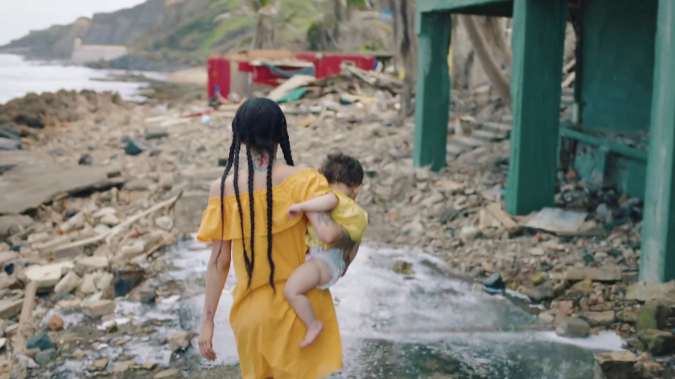Accepting the win for Best Music Video at this year’s SXSW Film Festival, Kristian Mercado expressed gratitude; more than once, he gave thanks that his work as director for Hurray for the Riff Raff’s “Pa’lante” — which delivers a poignant story of a working-class family’s life in pre- and post-Maria Puerto Rico — was recognized.
But his gratitude probably isn’t what the crowd assembled that day best remembers. What anyone who heard him won’t — and shouldn’t — forget, is the hurt that was palpable in his shouts, like a deep cry was welling just beneath the surface.
“I’m so tired of bearing my pain so that you can fucking humanize me,” Mercado began, and the room fell silent. “We lost 5,000 people. On fucking American soil.” And then he got louder — much louder: “5,000 DEAD PUERTO RICANS. Where is the response? WHERE IS IT?”
He continued, “I’m fucking hurting. We all are. Here! In your own fucking land! And at the border! Latinos will be heard!”

Speaking with Mercado by phone a month later, I ask about the speech: Was he angry? In its expression, people often confuse pain for anger, he responds. And to address the crowd with some canned response was next to impossible.
“I think I was just coming from a very real place at the time, because I was experiencing a lot, and feeling the weight of that project,” he says. “I didn’t have a good, rehearsed sense about it. I was just being myself.”
Mercado feels lucky that, in searching specifically for a Puerto Rican director, Hurray for the Riff Raff’s lead singer, Alynda Segarra, commissioned him: “It was like, of course I have to do this,” he thought. “Not only do I have to do it, but it’s important for me to do it.”
On “Pa’lante,” Nuyorican Segarra speaks to Puerto Rico’s history of oppression, and its people’s continued struggle – from the archipelago’s colonization to the mass sterilization of unwitting women in the ‘50s and onto the Nuyorican movement of the subsequent two decades. Segarra talks about humanity lost, and the unprecedented courage, despite it all, of Puerto Ricans who still move forward.
Filming was intensely personal for Mercado. Shot throughout the main island of Puerto Rico, including in his family’s hometown of Arroyo and nearby Guayama, “Pa’lante” was, in part, a way for Mercado to communicate the abandonment so many Puerto Ricans felt during the post-storm crisis. Lack of emergency aid, a failure to efficiently deliver basic supplies, the prolonged electrical outage — federal and local governments were jointly complicit in a negligent response that led to days, weeks and months of tragedies.
Mercado’s grandfather was among the many who died during that time, just days before he was scheduled to leave the island and stay with Mercado’s mother in Spanish Harlem. Lack of treatment for his sleep apnea, combined with the stress and exhaustion of trying to meet basic needs in the aftermath of the hurricane, took a physical toll; Mercado’s grandfather had a heart attack. The family spent three hours trying to keep him breathing while they waited for an ambulance. Ultimately, he died in Mercado’s uncle’s arms.
His aunt called around 3 am. Mercado cries as he recalls telling his mother the news.
“What ends up happening is that they can’t even put the body anywhere. They have, like, a mass grave where they were just holding bodies, and my grandfather’s in that, and being a veteran … but they just put him in there, and he doesn’t get buried for a long time,” Mercado says.
For eight months, his displaced family members took refuge at his mother’s apartment in Spanish Harlem. Mercado lived across the street; it was a time for them to “feel what’s important again,” he says.
Among them was his aunt, who Mercado enlisted in producing “Pa’lante.” Through the filming, she realized that, despite the trauma she’d experienced, she would return to live in Puerto Rico. “Even though it was a complicated, difficult experience for both of us, I think the silver lining is that she was like, this is home, and I need to go back. It actually helped her go back,” he says.

“Pa’lante” has impacted Mercado, too: His mission is renewed, redefined. He calls it “a pure awakening.”
Mercado sees the shortage of Latinx narratives in film, and the lack of widespread distribution or attention for the few that exist, as a reflection of general societal invisibility — and now he feels a stronger sense of urgency to tell those stories.
“Cinema is often the lens that people translate the world through,” Mercado says. “People consume a lot of media and consume a lot of film. So a lot of times, the most common lexicon that people have is movies. I feel like the perception has always been that Puerto Ricans don’t have cinema, and it’s like, fuck. But I feel like that’s also part of the challenge of what I’m trying to fight against as well. I want to show the world that we do have powerful, powerful cinema,” he says.
At the end of his SXSW acceptance speech, Mercado lowered his tone slightly. He briefly paused, focused, then issued a call to other Latinx filmmakers living in the poor neighborhoods of the United States, at the border towns, anywhere: “Share your voice. Share your vision. Don’t be silent,” he said. “Ahora. Nosotros somos el viento valiente. The brave wind. And now is the time.”




